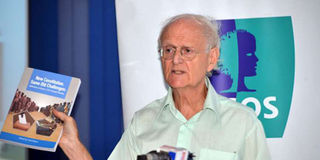How pollsters got it all wrong in the last two elections

Ipsos Synovate lead researcher Tom Wolf addresses the media at the company's office in Nairobi on December 23, 2015. PHOTO | SALATON NJAU | NATION MEDIA GROUP
The pollsters largely got it wrong in the past two elections when they showed ODM leader Raila Odinga in the lead only for President Uhuru Kenyatta to emerge the winner.
With elections barely five days away, Kenyans have been treated to numerous opinion polls forecasting what the actual General Election results would look like, and going by the past two elections, at times, the polls get it wrong.
Currently, the opinion polls conducted by several research firms agree on two things. One, Azimio la Umoja One Kenya Coalition presidential candidate Raila Odinga is ahead of his Kenya Kwanza counterpart, Deputy President William Ruto. Two, they agree that the difference margin between the two is slim.
The only exception so far is the recent Ipsos poll that placed Mr Odinga at 47 per cent against Dr Ruto’s 41; a significant difference margin of six per cent.
Roots Party presidential candidate George Wajackoyah is a distant third, with a rating of 2.9 per cent while Mr David Mwaure Waihiga of Agano Party has a rating of 0.2 per cent.
Two days before this Ipsos poll, Trends and Insights for Africa (Tifa) placed Mr Odinga at 46.7 per cent ahead of Dr Ruto who had 44.4 per cent, a slim 2.3 per cent margin. The poll showed Prof Wajackoyah of Roots party had 1.8 per cent while Mr Mwaure trailed at 0.1 per cent.
In mid-July, Tifa’s survey showed that 42 per cent of Kenyan voters identify with Mr Odinga compared to 39 per cent who said they will vote for DP Ruto. The poll had +/- 2.34 per cent margin of error.
In August 2017, an Ipsos survey showed that President Kenyatta had a 47 per cent rating among registered voters ahead of Mr Odinga who scored 44 per cent in a study conducted between July 22 and 30.
This poll came a few days after Infotrak had conducted a survey predicting a tight presidential contest, with Mr Odinga in the lead (49 per cent) against Mr Kenyatta (48 per cent).
When elections were held on August 8, 2017, the results were different. President Kenyatta was declared the winner of the presidential contest with 54.1 per cent, against Mr Odinga’s 44.9 per cent.
Both Ipsos and Infotrak surveys had indicated that neither Mr Odinga nor Kenyatta would attain the 50 per cent plus one vote rule and had foreseen a possible run off, this never materialised.
Ipsos’ survey, though, was almost right in its poll, suggesting Mr Odinga would claim 44 per cent in the poll compared to Infotrak that polled Mr Odinga at 49 per cent.
In 2013, a similar event happened. During the pre-election period, polls consistently showed Mr Odinga was ahead of Mr Kenyatta. However, in none of the polls did Mr Kenyatta’s popularity cross Mr Odinga’s even though both of them never passed the 50 per cent hallmark.
Since July 2011, Mr Odinga led the race with over 10 per cent points over his rivals. However, by July 2012, the tides changed with new polls showing Mr Odinga losing to either Mr Kenyatta or the other Deputy Prime Minister, Mr Musalia Mudavadi.
Ipsos Synovate found that Mr Kenyatta’s rating rose to 30 per cent in September, up from 23 per cent in July 2012.
Mr Odinga’s rating rose marginally to 36 per cent, up from 33 per cent in July.
Again, contrary to the pollster’s predictions, Mr Kenyatta won the elections garnering 50.3 per cent of the votes, translating to an error of approximately six per cent by pollsters.
Analysts later agreed that voter turnout played a significant role in determining who won the 2013 polls.




